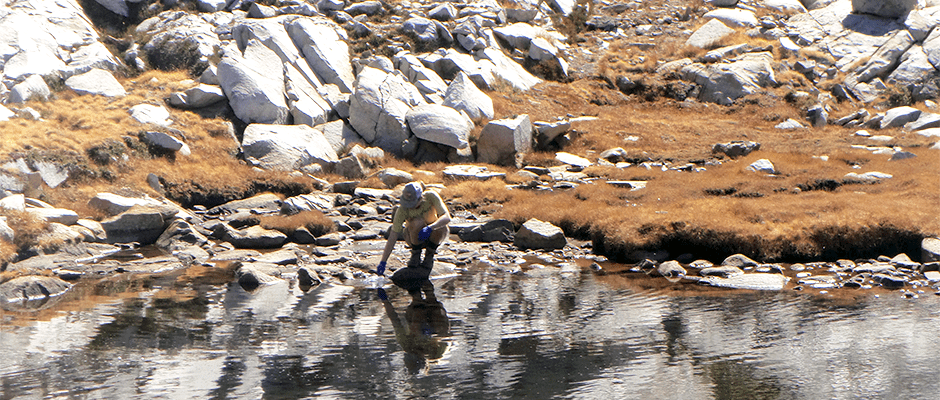Share this article
Could eDNA prevent frog die-offs from fungal disease?
When Collen Kamoroff was sampling the montane lake waters of eastern California, she was trying to ensure they no longer contained invasive fish. Instead, she found what she believes could be an effective method to halt the spread of a deadly disease that has decimated amphibians around the globe.
The environmental DNA — or eDNA — she and her fellow biologists were gathering, they discovered, could be analyzed to detect the chytrid fungus in the water, potentially allowing threatened frogs to be rescued before the disease causes severe die-offs.
“When you collect a water sample and filter it, you’re collecting all sorts of DNA in that water sample, from frogs, fish, insects as well as any type of fungus,” said Kamoroff, first author on the study published in Diseases of Aquatic Organisms.
As a master’s student at Washington State University, she used eDNA to support habitat restoration in the Sierra Nevada for the endangered mountain yellow-legged frog (Rana muscosa and Rana siserrae). With the technique, she confirmed that the National Park Service had eliminated trout (Oncorhynchus spp.) from the alpine lakes so the amphibians — which the introduced sportfish had devoured across 93 percent of the frogs’ historic range — could reestablish themselves. Although some of this species’ populations in the region have not yet been struck by the chytrid fungus, Batrachochytrium dendrobatidis, also known as Bd, the disease portends a “one-two punch for them” following the fish, Kamoroff said.
In 2015, when a healthy yellow-legged frog population at a sampling site succumbed to chytrid, she decided to check whether the fungus could be detected in the sample she’d obtained from that lake the previous month.
“I took that filter sample back to the lab and extracted all the DNA,” Kamoroff said. “Each organism has its own DNA code. We were looking for the specific DNA of chytrid as well as trout. We could run the waters samples for whatever we’re curious about — a certain insect we were wondering is in the water, a frog species or the Loch Ness Monster.”
Finding genetic material from Bd in that initial sample, she and her partners assessed samples from a dozen more lakes with chytrid-free yellow-legged frogs throughout Sequoia and Kings Canyon National Park. The researchers spotted the fungus in a total seven samples. Within a month of sampling, frog populations from three of those lakes lost many individuals to the disease.
The discovery gave her hope that detecting the chytrid eDNA early enough could allow scientists to step in and administer antifungal baths or other treatments to prevent frog mortality.
“This could be an early-detection tool to determine what populations may be susceptible prior to a die-off, so we can go in there and help — whether it’s a bath or captive rearing — so they can survive,” Kamoroff said.
Research outside the Sierra has found that eDNA can reveal the presence of Bd after it has infected populations, she said, and other work has shown that the quantity of fungal DNA in the water could correlate with the level of risk posed.
“eDNA is an exciting, innovative tool that can help with conservation,” she said.
This summer, Kamoroff plans to continue sampling at the parks to understand how the amount of chytrid in eDNA samples relates to the amount that appears on frogs and their likelihood of dying off.
Header Image: Wildlife biologist Colleen Kamoroff collects water filter samples in California’s Sequoia Kings Canyon National Park to process in the lab. ©Jessica Thompson








